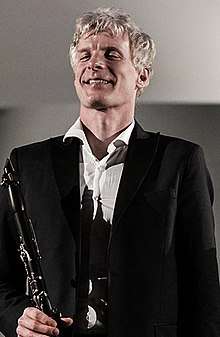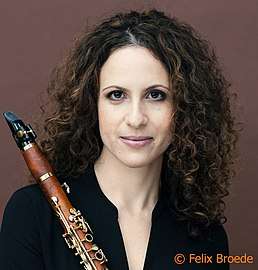Basset clarinet
The basset clarinet is a clarinet similar to the usual soprano clarinet but longer and with additional keys to enable playing several additional lower notes. Typically a basset clarinet has keywork going to a low (written) C or B,[1][2] as opposed to the standard clarinet's E or E♭. The basset clarinet is most commonly a transposing instrument in A, although basset clarinets in C and B♭ and very seldom in G also exist.[3] The similarly named basset horn is also a clarinet with extended lower range, but is in a lower pitch (typically F); the basset horn predates, and undoubtedly inspired, the basset clarinet.


 Modern basset clarinet with bell facing upwards (French system, made by Schwenk & Seggelke) | |
| Woodwind musical instrument | |
|---|---|
| Other names | German: Bassettklarinette, French: clarinette basset; Italian: clarinetto di bassetto; |
| Classification | Aerophon, clarinet-family |
| Inventor(s) | Theodor Lotz and others |
| Developed | since about 1770 |
| Playing range | |
1.   1. written 2. basset clarinet in A, playing | |
| Related instruments | |
| clarinet, clarinet d'amore, alto clarinet, basset horn | |
| Musicians | |
| Sabine Meyer, Charles Neidich, Vlad Weverbergh, Sharon Kam, Martin Fröst, Shirley Brill | |
| Builders | |
| Schwenk & Seggelke, Herbert Wurlitzer, Leitner & Kraus, Buffet Crampon, Selmer Paris, Stephen Fox (clarinet maker), Backun Musical Services | |

History
The earliest surviving instruments in Paris and London museums date from 1770. The basset clarinet was most notably associated with the clarinet virtuoso Anton Stadler (1753–1812), a contemporary and good friend of Mozart. The instrument used by Stadler was invented and built by the Vienna K.K. court instrument maker Theodor Lotz around 1788. It has long been unclear how this instrument might have looked. In a library in Riga in 1992 programmes were found of concerts which Anton Stadler played there in 1794. Two of those programmes show an engraving of Stadler's instrument (see picture on the right). The term "basset clarinet" was in use by 1796, though it may originally have referred to the basset horn.[4]
Mozart wrote his Clarinet Quintet in A major, K.581 and Clarinet Concerto in A Major, K.622 for this instrument; the concerto is partly based on an earlier fragment of a Concerto for Basset Horn in G, K.584b. In his last opera La clemenza di Tito, Mozart assigned a basset clarinet in B♭ in the aria Parto parto, ma tu ben mio, meco ritorna in pace by Sesto (mezzo-soprano) an outstanding solo role in an approximately 8-minute dialogue with the singer, the musical climax of this act, if not the whole opera.
Because Mozart's clarinet concerto is so important, the basset clarinet is quite an interesting instrument in spite of its small applicability. For the concerto the extension must be chromatic and the shape of the Viennese basset horn is not suitable for this.
Despite Stadler's advocacy the instrument did not become a regular member of the orchestra. During the 19th and early 20th centuries only a few basset clarinets were produced, for performances of Mozart pieces, and no further music was written for the instrument (see under External links: Mozarts's lost clarinet). However, beginning in the mid 20th century, interest in performing on original instruments prompted the basset clarinet's revival. A few modern composers, among them Bill Sweeney, Harrison Birtwistle, Alan Ray Hacker, Hannes Pohlit and Franklin Stover, have written works featuring basset clarinet; Joan Tower's 1988 Clarinet Concerto is written to be played on either basset or standard clarinet.[5]
Construction
The construction of a modern basset clarinet can be rectilinear, like a normal clarinet (see the two photos below right). However, the clarinet can have a bell, which is slightly upwards and forwards aligned via an angled intermediate piece (see photo above in the infobox). Charles Neidich has had a basset clarinet with modern mechanics built by Schwenk & Seggelke, which, like the Stadler clarinet, has an angled barrel and as a bell has a Liebesfuß, which he turns backwards, although one can turn it forward. The different types and directions of the bell have an influence on the sound.
Fingering of the basset tones
As noted above, a basset clarinet is most commonly an A-clarinet with an extension of a major third or perfect fourth down. In the case of historical instruments as well as those of the German system, the additional deep tones C, C sharp, D and E flat are fingered with the right thumb, likewise in the case of instruments of the French system made by German manufacturers (e.g. Herbert Wurlitzer and Leitner & Kraus), whereas the basset clarinets of the French system of other manufacturers (Buffet Crampon, France; Backun Musical Services, Canada) are equipped with two additional keys for both little fingers, with the exception of the Canadian manufacturer Stephen Fox, where both finger techniques are combined (the right thumb and the small left finger), see description and illustration.[6] The German manufacturer Schwenk & Seggelke offers, for basset clarinets with French system, optionally the thumb solution or a combination of both techniques:

.jpg)
.jpg)
Makers
Some clarinet makers now produce basset clarinets, or extended lower joints which will convert a standard clarinet to a basset clarinet. Among makers of basset clarinets using the French (Boehm) system are Buffet Crampon,[7][8] Stephen Fox (clarinet maker), Backun Musical Services, and Selmer.[9]
Some makers of both French and German (Oehler) systems: Herbert Wurlitzer, Schwenk & Seggelke and Leitner & Kraus. A maker of the German system only: Hüyng.[10] Makers of basset lower joints include Chadash[11] and Fox.
Performers
Classical clarinetists who have recorded albums using basset clarinet include Colin Lawson, David Shifrin, Antony Pay, Sabine Meyer and Kari Kriikku. Also Martin Fröst, Andreas Sundén, Sharon Kam, Shirley Brill, Roeland Hendrikx and Annelien Van Wauwe play the Mozart-concerto on a basset clarinet. The German clarinetist Theo Jörgensmann plays free jazz on a basset clarinet as does Los Angeles based performer Vinny Golia (who also uses the basset horn in his music). The British clarinetist Thea King recorded Mozart's Quintet and Concerto, both on the basset clarinet, for Hyperion Records, coupled together on one CD. Michael Collins, who studied with Thea King, has recorded the Mozart Concerto playing a basset clarinet (Deutsche Grammophon, along with a transcription for clarinet of Beethoven's Violin Concerto). With the North Carolina Symphony on April 10, 2008, Collins premiered Elena Kats-Chernin's Ornamental Air, which takes the form of a concerto for basset clarinet. Another British player, Joy Farrall, has also recorded Mozart's Concerto and Quintet (BMG and Meridian) using a basset clarinet, alongside the Kegelstatt Trio for clarinet, viola and piano. On period instruments, Jane Booth has recorded the Mozart Quintet with the Eybler Quartet (Analekta, 2010). Working in both practice and theory, Colin Lawson's celebrated recording of Mozart's Clarinet Concerto K. 622 with the Hanover Band for Nimbus, released in 1990, complements his Cambridge Handbook to Mozart’s Clarinet Concerto published in 1996.[12]
The American clarinetist Charles Neidich, the Italian Luca Lucchetta, the Dutch Vlad Weverbergh and the Swedish Stefan Harg, all committed to historical performance practice, play Mozart on replicas of Stadler's basset clarinet. Also in performances of Mozart's La clemenza di Tito, Sesto's aria "Parto, ma tu ben mio" increasingly uses the prescribed prominent basset clarinet in B♭ instead of a normal clarinet, as well as in concert performances of this aria at the performances of the 2017 Opera in Salzburg and 2018 in Amsterdam with the German clarinetist Florian Schuele.
 Sabine Meyer
Sabine Meyer Sharon Kam
Sharon Kam Martin Fröst
Martin Fröst Roeland Hendrikx
Roeland Hendrikx Shirley Brill
Shirley Brill Annelien Van Wauwe
Annelien Van Wauwe
References
- Fox, Stephen. "Basset clarinet and basset conversion". Stephen Fox Clarinets. Archived from the original on 2018-12-23.
- Rice, Albert R. (2016). "The Basset Clarinet: Instruments, Makers, and Patents". In Libin, L. (ed.). Instrumental odyssey: a tribute to Herbert Heyde. Hillsdale, New York: Pendragon Press. pp. 157–178. ISBN 978-1-57647-252-1. OCLC 932302591. Retrieved 2020-02-22.
- Rice, Albert R. (2003). The clarinet in the classical period. Oxford: Oxford University Press. ISBN 978-0-19-534381-6. OCLC 57124590.
- Rice, Albert R. (2003). The clarinet in the classical period. Oxford: Oxford University Press. pp. 72–73. ISBN 978-0-19-534381-6. OCLC 57124590.
- "Joan Tower – Concerto for Clarinet (1988)". Wise Music Classical. Archived from the original on 2018-10-11. Retrieved 2020-02-22.
- Fox, Stephen. "Basset clarinet, basset lower joint and conversion". Stephen Fox Clarinets. Archived from the original on 2007-01-14.
- "PRESTIGE Basset Clarinet in A BC 1223". Archived from the original on December 10, 2006.
- "Prestige Basset". Buffet Crampon. Archived from the original on 2019-09-26. Retrieved 2020-02-22.
- "Selmer Paris Clarinets". Selmer. Archived from the original on 2006-05-22. Retrieved 2006-11-22.
- "Meisterwerkstatt für Holzblasinstrumente". Harald Hüyng Düsseldorf (in German). Archived from the original on 2019-10-14.
- Chadash, Guy. "Basset A Extension and Bell". Chadash Clarinet. Archived from the original on 2007-09-30. Retrieved 2006-11-22.
- Colin Lawson, Mozart Clarinet Concerto (Cambridge Music Handbooks), ISBN 978-0521479295
External links
| Wikimedia Commons has media related to Basset clarinets. |
- Video: modern basset clarinet (Buffet/Fox), sound samples from the Allegro and the Adagio of the Mozart Concerto (2:06 min.)
- Video: modern basset clarinet (Backun), sound sample from the Adagio of the Mozart Concerto (53 sec.)
- Video: Mozart's lost Clarinet (58 min.)